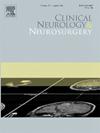Cerebral blood flow velocities measured by transcranial doppler are associated with magnetic resonance imaging biomarkers in moyamoya arteriopathy
IF 1.8
4区 医学
Q3 CLINICAL NEUROLOGY
引用次数: 0
Abstract
Purpose
In individuals with moyamoya arteriopathy, transcranial Doppler (TCD) may be a useful complement to MRI because of its safety, cost effectiveness, and ability to be performed without anesthesia in children. We evaluated associations between various MR-based moyamoya biomarkers and cerebral blood flow velocity (CBFV) as measured by TCD in individuals with moyamoya.
Methods
Participants ≤ 26-years-old with moyamoya who had not had surgical revascularization underwent TCDs within 14 days of surveillance brain MRIs. Associations between MRI parameters (Suzuki scores, cerebrovascular stenosis score, ivy sign, brush sign) and CBFV of the MCA and ICA were assessed.
Results
Twenty-six TCD-MRI pairs from 16 participants were analyzed. Median participant age was 7.3 (IQR 5.9–8.9) years. No associations between CBFV and Suzuki score or cerebrovascular stenosis score were identified. There was a significant positive association between MCA CBFV and degree of MCA stenosis between 0 % and 99 % stenosis (p = 0.02). Hemispheres without ivy sign had higher MCA CBFV compared with hemispheres with ivy sign (144 cm/s v. 105 cm/s, p = 0.02). Hemispheres with brush sign had higher CBFV compared with hemispheres without brush sign in both the MCA (232 cm/s v. 122 cm/s, p = 0.009) and ICA (213 cm/s v. 131 cm/s, p = 0.03).
Conclusion
In this cohort of children and young adults with moyamoya, higher MCA CBFV were associated with higher degrees of stenosis (but not complete occlusion), the presence of a brush sign, and the absence of the ivy sign. TCD may have an important role as an adjunct to traditional neuroimaging in moyamoya arteriopathy.
经颅多普勒测量的脑血流速度与烟雾病的磁共振成像生物标志物相关
目的:经颅多普勒(transcranial Doppler, TCD)在患有烟雾病的患者中可能是MRI的有效补充,因为它具有安全性、成本效益和在儿童中无需麻醉即可进行的能力。我们评估了各种基于mr的烟雾生物标志物与烟雾患者TCD测量的脑血流速度(CBFV)之间的关系。方法≤ 26岁的烟雾症患者,未进行手术血运重建术,在监测脑mri后14天内接受tcd。评估MRI参数(铃木评分、脑血管狭窄评分、常春藤征、刷状征)与MCA和ICA CBFV之间的关系。结果对16例患者的26对TCD-MRI进行分析。参与者年龄中位数为7.3岁(IQR 5.9-8.9)。CBFV与铃木评分或脑血管狭窄评分之间无关联。MCA CBFV与MCA狭窄程度在0 %和99 %之间呈显著正相关(p = 0.02)。无常春藤征象的半球MCA CBFV高于有常春藤征象的半球(144 cm/s vs . 105 cm/s, p = 0.02)。在MCA(232 cm/s vs . 122 cm/s, p = 0.009)和ICA(213 cm/s vs . 131 cm/s, p = 0.03)中,有刷状征象的半球CBFV均高于无刷状征象的半球。结论:在这组患有烟雾症的儿童和年轻人中,较高的MCA CBFV与较高程度的狭窄(但不完全闭塞)、刷状征象的存在以及没有常春藤征象相关。TCD可能在烟雾病中作为传统神经影像学的辅助手段发挥重要作用。
本文章由计算机程序翻译,如有差异,请以英文原文为准。
求助全文
约1分钟内获得全文
求助全文
来源期刊

Clinical Neurology and Neurosurgery
医学-临床神经学
CiteScore
3.70
自引率
5.30%
发文量
358
审稿时长
46 days
期刊介绍:
Clinical Neurology and Neurosurgery is devoted to publishing papers and reports on the clinical aspects of neurology and neurosurgery. It is an international forum for papers of high scientific standard that are of interest to Neurologists and Neurosurgeons world-wide.
 求助内容:
求助内容: 应助结果提醒方式:
应助结果提醒方式:


